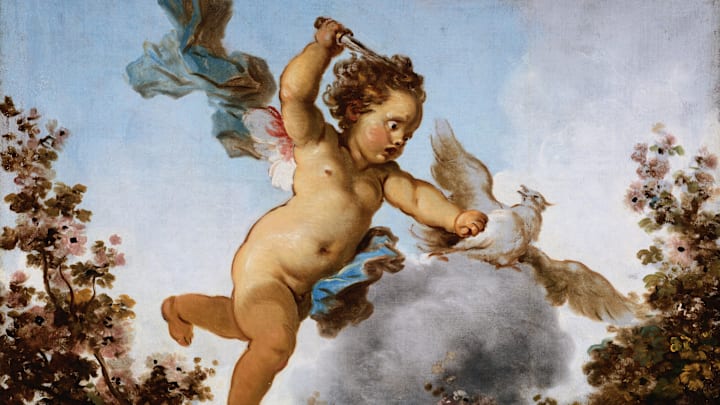Some Valentine’s Day traditions are considered romantic any day of the year, like giving red roses to your loved one or cooking them a fancy meal. But unless it’s February 14, images of a weapon-wielding naked baby don’t typically inspire warm and fuzzy feelings. Cupid may seem like a strange figure to slap on Valentine’s Day cards, but his connection to love and romance dates back centuries.
Before he was a chubby, winged cherub, Cupid was a fearsome deity. The original Greek god Eros was depicted as a handsome young man. Like his mother Aphrodite, he was associated with love and lust, but he also took after Ares, the god of war sometimes attributed as his father.
He used his famous bow and arrows for more than harmless matchmaking: One strike could consume his victims with uncontrollable—and sometimes unwanted—desire. This power was often used as a punishment rather than a gift. When he was insulted by Apollo, a vengeful Eros used his arrow to make the God fall in love with the virginal naiad Daphne. She wanted nothing to do with him, but he was relentless. The myth ends with Daphne’s father turning her into a tree to protect her from Apollo’s advances.

By the 4th century BCE, the image of Eros—or Cupid, as the Romans came to know him—had softened. People wanted a less aggressive god of love, and emphasizing his role as the obedient son of Aphrodite/Venus was a way to infantilize him. As the figure’s persona became more childlike, artistic depictions of him started to look younger, and in the Hellenistic period he fully transformed from a young man to a rosy-cheeked baby. This innocent image was reinforced centuries later by Renaissance painters like Caravaggio and Nicolas Poussin.
So how did a Roman god become the mascot of a Catholic saint’s day? Despite legends linking Valentine’s Day to the ancient Roman festival Lupercalia, the two celebrations likely have nothing to do with each other. The holiday may have originated as a feast day honoring two Saint Valentines, both of whom were martyrs. The day fell on February 14, which coincided with the start of spring in Britain in the Middle Ages. Geoffrey Chaucer highlighted the date as a romantic time of year (at least for birds) in his 1375 poem “Parliament of Foules.” He wrote: “For this was sent on Seynt Valentyne’s day / Whan every foul cometh ther to chese his mate.”
Throughout the Middle Ages into the Renaissance Era, both Valentine’s Day and the cherubic Cupid became independently associated with romantic love. So when exchanging cards become a popular Valentine’s tradition in the 18th and 19th centuries, Cupid naturally got involved. The love god appeared on Valentines connected to expressions of affection, and when Hallmark began mass-producing cards for the holiday in 1913, he became even more ubiquitous. Today, it’s nearly impossible to visit a drugstore in February without seeing the flying toddler.
Cupid isn’t the only Valentine’s Day tradition that dates back to Ancient Greece. According to mythology, Aphrodite created the first red rose when she scratched herself on a white rose’s thorn, and the flower has been associated with passion and love ever since. Here are more facts about the romantic holiday.
